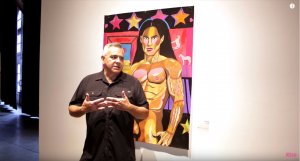In another work from Driskill, “Doubleweaving Two-Spirit Critiques: Building Alliances between Native and Queer Studies,” they ascribe one crucial aspect of Two-Spirit critiques as being “created and maintained through the activist and artistic resistance of Two-Spirit people” (Driskill, 2010, 81). Various forms of art that are referenced, such as poetry, dance, and visual art, represent how Two-Spirit critiques are realized and reach out to broader audiences. They exist as media to further demonstrate the material realities, histories and spiritualities that continue to be extinguished by the settler colonial status quo. More particularly, the use of visual art will be the locus of the following example of Two-Spirit artistic resistance.
The Vancouver Queer Arts Festival, which was recently held from June 17-29, included a curated Two-Spirit exhibition, named “UnSettled.” 18 artists participated and showcased their work in the exhibition. The head curator was Adrian Stimson, a visual artist from the Siksika Nation in Alberta. Stimson obtained a Master of Fine Arts degree from the University of Saskatchewan, and two of his paintings were recently given to the British Museum for its North American Indigenous collection. The purpose of the exhibition was exactly what Driskill mentioned—it provided a series of critiques that deal with the histories of colonialism, as well as alternative narratives to the LGBTQ mainstream. You can find the full curatorial statement on the event web page.
Most of the artists’ work was in the form of intersectional, vibrant, polychromatic paintings. In George Littlechild’s piece, Nanekawasis, he contends that sexuality should not be an experience with foundations of shame, but one that is rooted in humanity above all else. He elaborates in an interview that “Christianity has done such a number on us that there’s so much shame that gets placed on us, as human beings…especially as being a Two-Spirited person” (Dailyxtra, 2017). This gave Littlechild the impetus to paint a man who is completely naked—with the intention to “just bare it all” (Dailyxtra, 2017). In this case, “baring it all” entails providing an exposé of the grievances of growing up being shameful of Two-Spiritedness, and to reclaim sexuality from settler colonial dogma.

Driskill additionally highlights that “…Two-Spirit critiques remain accountable to both academic and nonacademic audiences” (Driskill, 2010, 82). The academic aspect of this art is to incorporate theory and textured nuance to the experience of Two-Spirit individuals, as indicated within the topics of the art exhibition, such as gender policing via residential schools and settler colonial violence. The nonacademic aspect is the accessibility of this art to those who may not possess the vocabularies of academic language, as well as to translate theory into thought-provoking, interpretable, visual forms. These efforts uphold the role of broader organizing—to amalgamate knowledge, and thus power, to the community, with the long term goal of resistance and reclaiming decolonized ways of being.
Dailyxtra. (2017, June 23). How two-spirit artists unsettle the Vancouver Queer Arts Festival [Video file]. Retrieved from https://www.youtube.com/watch?v=jj180bgH4jg
Driskill, Q. (2010). Doubleweaving Two-Spirit Critiques: Building Alliances between Native and Queer Studies. GLQ: A Journal of Lesbian and Gay Studies, 16(1-2), 69-92.